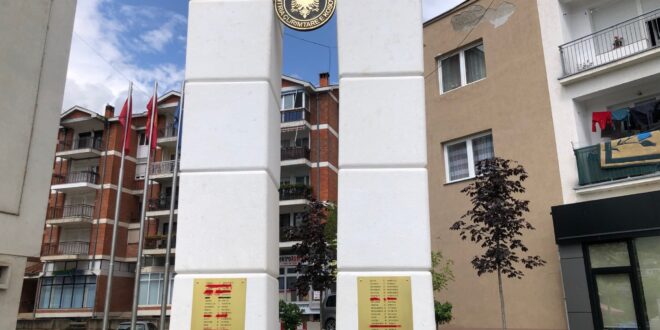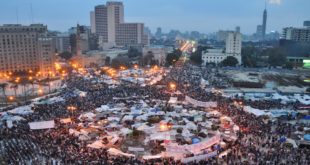A dispute about engraving civilians’ names on a monument to deceased fighters in a small Kosovo town highlighted a wider problem: although most people killed in the 1998-99 war were civilians, most war memorials commemorate guerrillas.
For more than 20 years, the name of Adem Ahmetaj’s nephew Jeton could be seen on a small memorial plaque in the western Kosovo city of Istog/Istok commemorating around 50 people who died fighting during the war in 1998-99.
But last month, a new monument was installed in the centre of the city: two white columns with a Kosovo Liberation Army insignia at the top. The new monument has two plaques listing 13 more names than the previous memorial – all of them civilians, war victims who were never before registered as being members of the KLA. One of them is Ahmetaj’s brother, Ismet.
The addition of the 13 new names sparked anger among some relatives of former KLA guerrillas who argued that because they were killed as civilians, they should be remembered as civilians, not as fallen fighters.
Former guerrilla Fikret Shatri crossed out the name of his brother who died while serving with the KLA during wartime; other family members of KLA members who died during the war did the same, and now the plaques are disfigured by red spraypaint and black magic marker where various deceased guerrillas’ names have been blocked out. “What’s happened is shameful. I don’t want the name of my brother to be among those names [of civilians],” Shatri told BIRN.
He and other ex-guerrillas have filed a criminal complaint against the government’s Commission for the Recognition and Verification of the Status of Martyrs, Invalids and War Veterans and against the War Martyrs’ Association in Istog/Istok, which installed the new monument.
“This is a matter of falsification for personal and political interest of some KLA commanders and an attempt to get some false credit of pride [for the families of civilians who were killed],” Shatri said.
But he stressed that above all the strong reaction was necessary because “killed civilians were never memorialised with dignity” in Kosovo.
‘Martyrs’ memorials dominate’
As in Istog/Istok, civilians killed during the war have mostly not been commemorated on memorial plaques in Kosovo, although a large majority of the 13,500 people who were killed – more than 11,000 of them – were civilians.
When civilians killed in the war have been commemorated, it has often been by including their names in the same plaques that commemorate KLA fighters, rather than with separate memorials.
“The majority of victims are civilians and number of memorials is deeply disproportionate because the KLA martyrs’ memorials dominate,” Bekim Blakaj the head of the Pristina-based Humanitarian Law Centre, which has registered all victims of the war, told BIRN. “That’s why it is necessary to have a comprehensive memorialisation policy,” he said.
Blakaj pointed out the families of civilian victims also receive less money in welfare benefits than the families of fighters who were killed. “This has created an inequality among the victims,” he said.
The issue of the official status of people who were killed or disappeared during and after the war has remained problematic for two decades.
“This matter has received little attention, even in the ongoing trial in the so-called ‘veterans’ case,” Blakaj said.
The contested process of verifying people who applied to be registered as KLA war veterans, making them eligible for welfare benefits, caused a huge scandal in Kosovo and has led to a long-running court case. Twelve 12 former KLA members who were working as government officials are accused of inflating the lists of veterans and including many civilians in the list of fighters who were killed.
The Commission for the Recognition and Verification of the Status of Martyrs, Invalids and War Veterans has also been criticised for its lack of transparency. Critics argue that it needs proper oversight and supervision.
“There were many irregularities. As a result, many civilian victims were arbitrarily given the status of martyrs [KLA fighters who were killed],” Blakaj said.
In Istog/Istok, Ahmetaj said his brother, whose name was recently added to the controversial memorial, was actually a KLA member and served in their village, Zabllaq/Zablac. He said he does not know why he is not listed as having been part of the guerrilla force and has no idea how to rectify the situation.
“I have no proper door to knock on. But the truth is that my brother and my nephew were members of the KLA despite the fact that my brother was in the shadows,” he said.
Ahmetaj said that his brother and nephew were taken away along with a group of civilians and killed in a house in the neighbouring village of Staradran.
Civil society organisations like the Humanitarian Law Centre have suggested creating an additional mechanism to review the status of people who were killed during and after the war in Kosovo, especially in contested cases.
“With this, we would have a documented record and the creation of an incorrect narrative about the war in Kosovo would be prevented,” Blakaj explained.
‘Big mistakes were made’
Xhavit Jashari, the head of the Associations of KLA Martyrs, said that the issue of the new monument in Istog/Istok should be decided by the court.
“I really don’t know why some people are reacting now while they could in 2000 when we published lists [of KLA fighters who were killed],” Jashari told BIRN.
“But we are aware of the big mistakes that were made because civilians were not given space in the memorials. It like denying their existence. There are still no proper memorials as healing places,” he added.
Lejla Gacanica, a Sarajevo-based legal adviser for TRIAL International, an NGO that provides legal assistance to victims of human rights abuses, said that civilian war victims are being “marginalised or forgotten” while deceased guerrillas are celebrated.
“In some cases they committed crimes but are still hailed as heroes, while the civilian victims never received proper recognition for their suffering,” Gacanica said.
The Agency for the Management of Memorial Complexes in Kosovo was established in 2013, but most of the war memorials in the country were installed before that and the agency has not been able to successfully regulate subsequent monument-building.
Bislim Zogaj, the head of the agency, insisted however that a lot of memorials to civilian victims are now being built.
“So far we have built 42 memorials to civilians killed in some of the massacres in Kosovo and each of them has the exact number of victims recorded,” Zogaj told BIRN.
However, there are currently more than 1,600 war memorials around Kosovo, mostly dedicated to guerrillas, and the authorities don’t have any legal guidelines to regulate the chaotic construction process.
“Memorials have been erected everywhere without any professional or ethical criteria,” said Blakaj.
In Istog/Istok, local mayor Ilir Ferati said that there was no debate in the municipal assembly about the installation of the new memorial and that the municipality wasn’t legally involved in the process or responsible for verifying the names.
“Now we will give them time to resolve the dispute and wait for the court decision,” Ferati told BIRN.
However, it could be years before there is a court ruling on the legality of adding the civilians’ names to the list of war dead on the memorial.
 Eurasia Press & News
Eurasia Press & News



